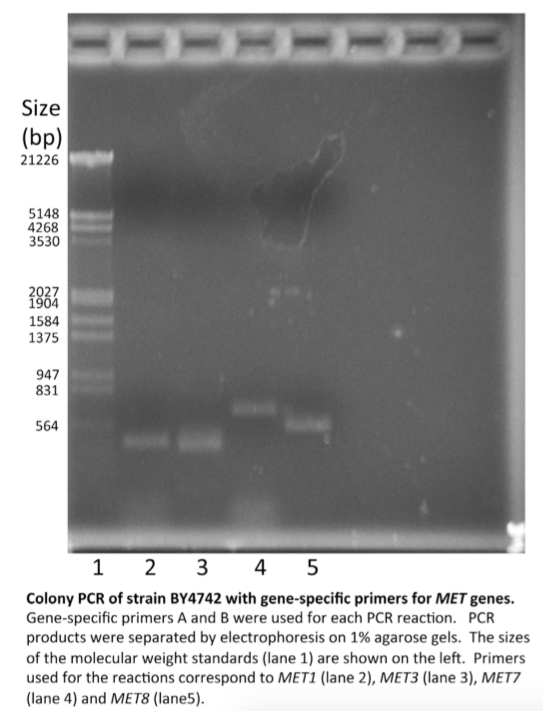16.3: Micro-report 2- Yeast colony PCR
- Page ID
- 17596
\( \newcommand{\vecs}[1]{\overset { \scriptstyle \rightharpoonup} {\mathbf{#1}} } \)
\( \newcommand{\vecd}[1]{\overset{-\!-\!\rightharpoonup}{\vphantom{a}\smash {#1}}} \)
\( \newcommand{\id}{\mathrm{id}}\) \( \newcommand{\Span}{\mathrm{span}}\)
( \newcommand{\kernel}{\mathrm{null}\,}\) \( \newcommand{\range}{\mathrm{range}\,}\)
\( \newcommand{\RealPart}{\mathrm{Re}}\) \( \newcommand{\ImaginaryPart}{\mathrm{Im}}\)
\( \newcommand{\Argument}{\mathrm{Arg}}\) \( \newcommand{\norm}[1]{\| #1 \|}\)
\( \newcommand{\inner}[2]{\langle #1, #2 \rangle}\)
\( \newcommand{\Span}{\mathrm{span}}\)
\( \newcommand{\id}{\mathrm{id}}\)
\( \newcommand{\Span}{\mathrm{span}}\)
\( \newcommand{\kernel}{\mathrm{null}\,}\)
\( \newcommand{\range}{\mathrm{range}\,}\)
\( \newcommand{\RealPart}{\mathrm{Re}}\)
\( \newcommand{\ImaginaryPart}{\mathrm{Im}}\)
\( \newcommand{\Argument}{\mathrm{Arg}}\)
\( \newcommand{\norm}[1]{\| #1 \|}\)
\( \newcommand{\inner}[2]{\langle #1, #2 \rangle}\)
\( \newcommand{\Span}{\mathrm{span}}\) \( \newcommand{\AA}{\unicode[.8,0]{x212B}}\)
\( \newcommand{\vectorA}[1]{\vec{#1}} % arrow\)
\( \newcommand{\vectorAt}[1]{\vec{\text{#1}}} % arrow\)
\( \newcommand{\vectorB}[1]{\overset { \scriptstyle \rightharpoonup} {\mathbf{#1}} } \)
\( \newcommand{\vectorC}[1]{\textbf{#1}} \)
\( \newcommand{\vectorD}[1]{\overrightarrow{#1}} \)
\( \newcommand{\vectorDt}[1]{\overrightarrow{\text{#1}}} \)
\( \newcommand{\vectE}[1]{\overset{-\!-\!\rightharpoonup}{\vphantom{a}\smash{\mathbf {#1}}}} \)
\( \newcommand{\vecs}[1]{\overset { \scriptstyle \rightharpoonup} {\mathbf{#1}} } \)
\( \newcommand{\vecd}[1]{\overset{-\!-\!\rightharpoonup}{\vphantom{a}\smash {#1}}} \)
In this report, you will describe the results of the yeast colony PCR experiment that you designed to identify the met deletions in your three YMP strains. The products of your PCR reac- tion will be separated on agarose gels similar to this one prepared by students in another class.

Note the following features of this figure:
- The gel is shown with the loading wells at the top.
- Lanes are clearly marked. In this figure, the lanes are numbered. The strains and primers used for each reaction are de- scribed in the legend. Alternatively, the lanes could be labeled with the names of strains and primers, taking care that they remain readable. Conclusions are NOTincluded in the legend.
- The sizes of the markers are indicated. (Your markers will be different.)
The reader will need to refer to the M&M for additional details on the strain genotypes and the PCR procedure.
Specific guidelines micro-report 2 follow.
Materials and Methods: Provide information on the specific strains and primers that you used, as well as the procedures for PCR and agarose gel electrophoresis.
Strains: See micro-report 1 guidelines.
Primers: In a publication, authors usually include the sequences of their PCR primers in the text or a table. You should include the names of the MET genes, but you do NOT need to in- clude the actual sequences, because these are listed in Chapter 7 of the manual. Be sure to cite the manual, however. Use the correct terminology when you refer to primers. GSP-A primers are sense primers that correspond to 5’-flanking sequences of the MET genes. GSP-B primers are antisense primers that are complementary to ORF sequences.
PCR: The PCR methods are described in the manual. “PCR reactions were performed as de- scribed (ref.)” is adequate. If you made any modifications, however, you need to describe theme.g. ...”with the following modifications”....
Agarose gel electrophoresis: The PCR reaction products were analyzed on agarose gels that were stained with ethidium bromide. Describe the conditions that you used to analyze the PCR products. Include the concentration of agarose, the name of the buffer and the voltage. In very general terms describe this analysis. Refer readers to the manual for additional details.
Results and Discussion: The figure with your gel is the focal point of this section. Briefly de- scribe your experimental design and the logic underlying your choice of primers.
As you discuss your results, remember that the bands you see on the agarose gel are PCR products. Size is very important in interpreting the results of a PCR experiment. As you prepared for the experiment, you calculated the sizes of PCR products that would confirm/not confirm your predictions. Did your experimental results confirm your predictions?
If your results did not confirm your predictions, you need to consider if the predictions were wrong OR if the reactions did not work. Did you see bands in any lane? If so, the PCR re- agents were probably not at fault. What else might have happened?
A single summary data table with the predicted and observed sizes of the PCR products would be helpful. The predicted sizes should very accurate, since they are based on the actual ge- nome sequence, which has nucleotide resolution. Your estimated sizes are much less accurate. You may be able to determine if one PCR product is smaller than another, but you will only be able to place the products within a certain size range.


